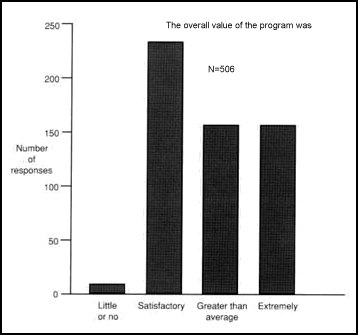Fall 1987 // Volume 25 // Number 3 // Feature Articles // 3FEA8
Creating Educational Excellence
Abstract
The need for educational excellence has received national attention in recent years. Primarily, the focus has been on curriculum and classroom instruction; however, all phases of education are now being reviewed for credibility and relevance. Likewise, Extension needs to examine the effectiveness of in-aservice education for district and county employees.
In-service education has been defined as:
Education received in a structured setting that enables one to become more competent professionally, i.e., to further develop technical subject matter competencies to keep abreast of and, if possible, ahead of change; to explore educational and technological content and processes in varying depths and to extend personal competencies....1
Television, cable television, telephone conferencing, and traditional in-service education methods have been studied and reviewed for their effectiveness, acceptance, and cost.2 Satellite videoconferencing is a new, nontraditional teaching technique. The study discussed in this article was designed to determine the teaching effectiveness of satellite videoconferencing with phone-in questions. Viewer acceptability from the public's point of view was also evaluated.
The Video Program
A live, two-hour videoconference, "Calcium-Osteoporosis and Beyond," was produced from Oklahoma State University by the food and nutrition specialists in cooperation with the Agricultural Information Department. The program was received by 24 sites across Oklahoma and 18 known sites outside the state. Program panel members accepted phone calls and answered questions on a live call-in.
Study Methods
Questionnaires were distributed to the public at each of the Oklahoma sites to evaluate viewer acceptance of the program. Teaching effectiveness of the video meeting as a substitute for traditional in-service education was studied in three Oklahoma districts by comparing:
- satellite videoconference with phone-in questions,
- training by on-site lecture, and (3) a combination of both methods (videoconference and lecture). Before each training session, home economists completed a knowledge pre-test on calcium and osteoporosis. The same test was repeated following each in-service session.
Analysis of variance was performed on pre-test scores to confirm consistent baseline knowledge among groups.3 Pre- and post-test scores and improvement scores were evaluated by analysis of variance and t-tests to compare the effectiveness of the three educational methods.4
Results
Public Acceptability
The video meeting was evaluated by the public for acceptability and viewer appeal. Overall, the results indicated that they: (1) would attend another video meeting, (2) thought the program was excellent or good, and (3) would try to include more milk in their diet. Figure 1 illustrates the public's opinion on the depth or the level of subject-matter presentation.
Teaching Effectiveness
No significant differences existed among the three groups' pre-test or post-test scores, indicating equivalent baseline and ending knowledge. Also no significant difference existed in improvement scores, suggesting that all three groups had equivalent knowledge improvement scores.
All teaching methods were highly significant for acquisition of knowledge (p<0.0002), with a mean improvement of 20%. There were no significant differences among the three teaching strategies. This indicates that all of the methods were equally effective in improving knowledge. Therefore, satellite videoconferencing needs to be taken seriously for its efficient and effective use as a substitute for on-site lectures.
Cost Comparison
Twenty-four counties in Oklahoma received the videoconference, with a cumulative audience of 788 viewers. The total cost of the video meeting, including production costs, air time, and uplinking charges, was $2,300. The per person cost was $2.91 for the in-state audience; 18 known sites received the program outside of Oklahoma. In contrast, the program would have cost $9.13 per person if the speakers had traveled to all 24 sites, assuming an attendance of 788.

Figure 1. Public's opinion on depth of subject-matter presentation.
Conclusion
Videoconferencing can be an acceptable, effective, cost-efficient substitute for traditional in-service training. Following the video conference, use of the videotape augments specialists' outreach efforts even further. Other advantages include the ability to maintain and increase the level of program delivery in a time of limited resources and enabling staff to reach nontraditional audiences.
Footnotes
1. National Policy Guidelines for Staff Development (Durham: University of New Hampshire, Cooperative Extension Service, 1977) and Keith L. Smith, "Does In-Service Make a Difference?" Journal of Extension, XXIII (Winter 1985), 5-7.
2. Smith, "Does In-Service Make a Difference?" Mary Beth Lang, Kristina L. Blacklock, and Boyd E. Rossing, "Is Anyone Watching?" Journal of Extension, XXIV (Summer 1986), 7-10; and Jan Bjorkland and Joanne Fredmeyer, "Keeping Current Via Teleconferencing," Journal of Extension, XXIII (Summer 1985), 21-24.
3. SAS Institute, SAS User's Guide: Basics (Cary, North Carolina: SAS Institute, Inc., 1982).
4. Ibid.
